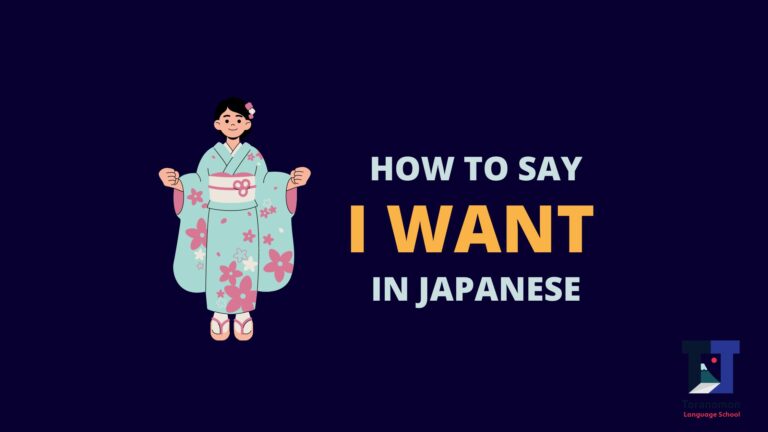If you’re interested in learning Japanese, one of the first things you’ll need to learn is how to express what you want to do. Luckily, Japanese has a simple and useful construction for expressing desires: ~たいです(~tai desu).
What is ~たいです and how to use it
This form of saying “I want” is used for verbs.
~たいです is a Japanese verb construction that expresses a desire to do something. It’s made up of the stem of the verb (the part before the ます ending) plus たい, which means “want to do.” To make it more polite, add です at the end.
For example, if you want to say “I want to eat sushi,” the verb for “eat” is 食べる (taberu). To use ~たいです, you would take the stem of taberu (食べ) and add たい to make 食べたい (tabetai). Then, you would add です at the end to make it polite: 食べたいです (tabetai desu).
Using ~たいです in Japanese
To use ~たいです, follow these steps:
- Take the stem of the verb (the part before the ます ending).
- Add たい to express the desire to do the action.
- Add です at the end to make it polite
Here’s an example using the verb 遊ぶ (asobu) which means “to play.”
Plain form: 遊ぶ (asobu) Stem: 遊び (asobi) Add たい: 遊びたい (asobitai) Add です: 遊びたいです (asobitai desu)
And here’s another example using the verb 行く (iku) which means “to go.”
Plain form: 行く (iku) Stem: 行き (iki) Add たい: 行きたい (ikitai) Add です: 行きたいです (ikitai desu)
Using ~たいです to make requests
In addition to expressing desires, you can also use ~たいです to make requests. For example, if you want to ask someone if they want to go to a movie with you, you could say:
映画を見たいですか?(Eiga o mitai desu ka?) Do you want to watch a movie?
In this case, you’re using ~たいです to ask if the other person has a desire to watch a movie with you.
Examples of ~たいです in use
Here are some examples of how to use ~たいです in everyday conversation.
- 食べたいです。(Tabetai desu.) I want to eat.
- 寿司を食べたいです。(Sushi o tabetai desu.) I want to eat sushi.
- 映画を見たいです。(Eiga o mitai desu.) I want to watch a movie.
- 旅行に行きたいです。(Ryokou ni ikitai desu.) I want to go on a trip.
- 日本語を勉強したいです。(Nihongo o benkyou shitai desu.) I want to study Japanese.
- 友達と遊びたいです。(Tomodachi to asobitai
What is 欲しい (hoshii) and how to use it
In addition to ~たいです, another common way to express desires in Japanese is by using 欲しい (hoshii), which means “to want” or “to desire.” While ~たいです expresses a desire to do something (aka a verb), 欲しい expresses a desire to have something.
Using hoshii to say “I want”
To use hoshii, follow these steps:
- Take the noun that you want (the thing you desire).
- Add が (ga) after the noun.
- Add 欲しい (hoshii) at the end.
For example, if you want to say “I want a book,” the word for book is 本 (hon). To use hoshii, you would add が after hon to make 本が (hon ga), and then add 欲しい at the end to make 本が欲しい (hon ga hoshii).
Here’s another example using the noun コーヒー (koohii) which means “coffee.”
Noun: コーヒー (koohii) Add が: コーヒーが (koohii ga) Add 欲しい: コーヒーが欲しい (koohii ga hoshii)
Using hoshii to make requests
Like ~たいです, you can also use hoshii to make requests. For example, if you want to ask someone if they want something, you could say:
何が欲しいですか?(Nani ga hoshii desu ka?) What do you want?
In this case, you’re using hoshii to ask if the other person has a desire for something.
Examples of hoshii in use
Here are some examples of how to use hoshii in everyday conversation.
- 本が欲しいです。(Hon ga hoshii desu.) I want a book.
- コーヒーが欲しいです。(Koohii ga hoshii desu.) I want coffee.
- お金が欲しいです。(Okane ga hoshii desu.) I want money.
- 車が欲しいです。(Kuruma ga hoshii desu.) I want a car.
- 犬が欲しいです。(Inu ga hoshii desu.) I want a dog.
- 彼女が欲しいです。(Kanojo ga hoshii desu.) I want a girlfriend.
Note that hoshii is always used in the present or future tense, as it expresses a current desire or want. If you want to express a past desire, you can use the past or future tense of the verb 欲しい (hoshii) instead.
The past tense of 欲しい (hoshii) is 欲しかった (hoshikatta). This form is used to express a past desire or want. For example, if you wanted a book yesterday, you could say:
昨日、本が欲しかったです。(Kinou, hon ga hoshikatta desu.) Yesterday, I wanted a book.
Similarly, the negative past tense of hoshii is 欲しくなかった (hoshiku nakatta), which means “did not want” in the past tense. For example:
昨日、コーヒーが欲しくなかったです。(Kinou, koohii ga hoshiku nakatta desu.) Yesterday, I did not want coffee.
Learning how to express your desires in Japanese is an essential part of becoming proficient in the language. By mastering the construction of ~たいです and 欲しい, you can easily convey what you want to do or have in any given situation. If you want help from a teacher in using “I want” in Japanese, try our beginner Japanese classes.

